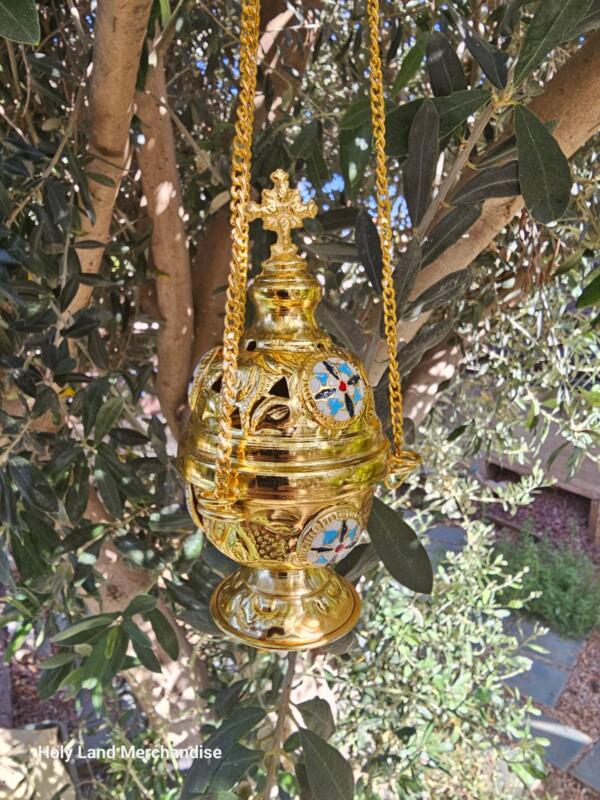The Orthodox Christian tradition is deeply rooted in symbolism, ritual, and sensory experience. One of the most visually and spiritually significant objects used during liturgical services is the thurible, also known as a censer. This article explores the meaning, construction, and use of the Orthodox thurible, shedding light on how a simple brass vessel becomes a sacred link between heaven and earth.
Origins and Symbolism of the Thurible
The thurible has been a part of Christian worship since the earliest centuries of the Church. Its use is inspired by Old Testament practices, particularly in the Temple of Jerusalem, where incense was burned as an offering to God. In both the Orthodox tradition and the use of the Catholic church thurible, the rising smoke of incense represents the prayers of the faithful ascending to heaven. The sweet aroma is symbolic of divine presence, purification, and sanctification.
Each time the thurible swings and releases fragrant smoke, it creates a sacred atmosphere meant to open hearts to worship. It is used to honor holy icons, the Gospel book, the altar, clergy, and the congregation, all of whom reflect the presence of God.
Structure and Materials of the Orthodox Thurible
An Orthodox thurible is typically crafted from brass, chosen for both its durability and symbolic brightness. The vessel consists of several key components: a rounded bowl that holds the hot charcoal and incense, a vented dome lid to allow smoke to rise, and a chain mechanism for swinging the censer during services. Most thuribles feature three or four chains that converge at a handle. This allows the thurifer to control its motion. Many designs include small bells on the chains. The bells produce a light sound during the liturgy. Their sound draws attention and enhances the sense of mystery.
The Role of Incense in Orthodox Worship
Incense plays a central role in the Orthodox liturgical tradition. During Divine Liturgy and other services, incense is burned at specific moments to emphasize solemnity, invite reverence, and consecrate the space. It is used during processions, scripture readings, and before the elevation of the Eucharist.
The type of incense used—often frankincense or myrrh—adds another layer of symbolism, connecting modern-day worshippers to the gifts brought to Christ by the Magi. The scent serves as both an offering and a reminder of the sacredness of the moment.
Use of the Thurible in the Liturgy
The thurible is handled by a deacon or altar server known as the thurifer. During services, the thurifer follows specific motions and rituals, censing the altar, clergy, icons, and congregation in a carefully ordered sequence. These actions are more than ceremonial; they reflect deep theological meanings about the presence of God in the Church and among His people.
Censing is often accompanied by silent prayer or hymns, and the physical act of swinging the thurible becomes an expression of devotion and reverence. In monasteries and some parish churches, the thurible is used multiple times throughout the day for morning and evening prayers.
A Devotional Object Beyond the Church
While the thurible is most commonly seen in church settings, it also holds value in private devotional life. Many Orthodox Christians keep small thuribles in their homes to use during family prayers, feast days, or moments of personal reflection. Lighting incense at home is a way to sanctify the space and foster a deeper connection with the divine.
Handmade thuribles, especially those from the Holy Land, are cherished not only for their function but for their beauty and craftsmanship. As each one is carefully constructed by artisans, it becomes both a tool of worship and a symbol of faith.
Also check. Choosing the Right Bathroom Door Singapore for Your Space
Preserving a Sacred Tradition
The Orthodox thurible is more than a liturgical accessory. It is a vessel of meaning, history, and prayer. The thurible has ancient roots in worship and remains vital in modern liturgies. It reminds the faithful of God’s mysterious presence. The beauty of Orthodox tradition is reflected in its continued use today. Whether in a grand cathedral or a small home chapel, it inspires reverence. As it swings, it releases sacred smoke filled with devotion and prayer. That smoke rises gently, symbolizing prayers lifted toward the heavens above.
Conclusion
In every swing and every wisp of rising smoke, the Orthodox thurible speaks to the heart of Christian worship—a union of the earthly and the divine. Its enduring presence in services today is a testament to the timeless power of ritual, beauty, and sacred tradition. The thurible serves both a functional and symbolic role in Christian worship.
It enhances the spiritual atmosphere with sacred incense. As it swings, it calls believers to lift their prayers toward heaven. Each movement carries the fragrance of reverence and love. The Church preserves this tradition with deep respect for its heritage. It also welcomes new generations into the mystery of faith through the senses.


